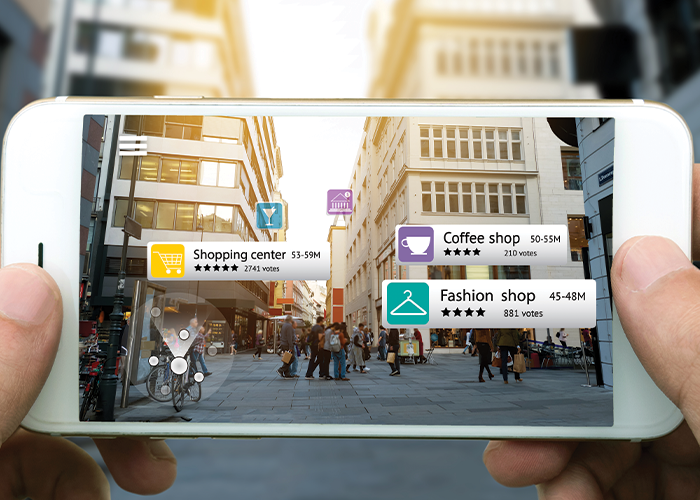7 Examples of Retailers Making Use of Augmented Reality

The growing influence of augmented reality (AR) has led many retailers to integrate AR-enabled applications and devices into their businesses. With every passing year, the trend is getting bigger and better.
Today, retailers are using this technology to give their shoppers a more real-life experience of using their products, aiding them in their buying decision.
Check out what statistics forecast about the future of this emerging technology:
Markets and Markets shares facts on how marketers are spending more money on AR, and according to its website, marketers forecast the revenue of AR to hit $61.39 billion dollars by 2023, which means it is going to increase by 55.71 percent annually over the next five years.
According to a survey by Retail Perceptions, 40 percent of consumers are likely to spend more on a product if they can experience it through AR. Additionally, 61 percent of shoppers want to buy from retailers that offer AR over those retailers who don't.
Furthermore, the survey also reveals that 71 percent of consumers would buy more frequently from a retailer who integrates AR in its business.
These changing realities in retail businesses point to one thing: AR is the next big game changer in the industry.
Many retailing brands are putting AR into practice as they market and sell their products, and below are seven leading examples.
1 - IKEA
One of the leading furniture manufacturers in the world, IKEA was quick to adopt AR technology to assist its shoppers in making better buying decisions. In 2017, the company collaborated with Apple and built the "IKEA Place" app that allows shoppers to see IKEA products in a superimposed graphics environment.
With help of the app, shoppers are able to purchase the right furniture to match the colors, style, and overall look of their living spaces. With IKEA Place, shoppers can view a piece of furniture against the background of their own homes. The app gives shoppers 98 percent accuracy in their buying decision, resulting in high customer satisfaction.
2 - The Gap
To avoid going through the hassles of finding clothes that fit perfectly, Gap created the "DressingRoom" app that allows users to try out a dress on a virtual mirror, cutting down on the time and effort of going into a fitting room. With the availability of this app, shoppers are able to try an outfit and pick the one that best fits their sizes and tastes.
Once the customer enters the measurements of her body in the app, she will be able to see a life-size mannequin wearing the clothing she intends to buy. If she likes the style and fit, she can buy the clothing through the app. Isn't it simple?
3 - Converse
Converse is a popular shoe brand that is a part of the Nike family, and is particularly known for its wide range of branded shoes. To let users get a real-time experience of a product, it launched the "Converse Sampler App."
Using this app is a breeze for shoppers as they can simply angle their camera to their feet and can take a snap of the shoe they intend to buy. They can even share the photo with friends and family and seek their opinion on choices.
Converse makes it significantly easier for shoppers to choose a shoe based on what they see through the app.
4 - Burberry
Burberry is another notable mention in this list as it uses AR to assist its customers in making a right buying decision. It collaborated with Danny Sangra to create superimposed graphics that users can use in their photos
Similar to Snapchat, it uses an overlay of different graphics effects that users can add to their photos. This offers a more interesting way for Burberry to connect with its audience and promote its brand.
5 - L'Oreal
L'Oreal is an international cosmetic brand that recently purchased ModiFace, an app that helps customers get a feel of their makeup through the front-camera of their smartphone.
With this app, customers can see the effects of different cosmetics products. The idea resonated well with its audience and the move helped L'Oreal scale its sales up five percent to eight percent.
6 - BIC
The stationary brand came up with the idea of providing students with a fun way to draw sketches. It rolled out an AR-enabled accessory to let students draw sketches and scan them through an AR-enabled device with superimposed graphics. It is more like a gamification app that students can use in their studies to play around with their artwork.
What is commendable about this app is that it does not just sell a product but adds value to the learning process. With this app, BIC makes sketching a fun task for students.
7 - Lego
Lego is tactical in using AR-technology for its product. In 2008, it teamed with Metaio to create an app that enables its buyers to see what a Lego construction would be like after completion.
Lego Digital Box (LDB), as it is called, is a box that kids can put in front of an AR-enabled display to see an actual construction of the bricks.
The new feature not only makes it easier for parents to buy the right Lego set for their kids, but also provides a fun way for the brand to engage with its audience.
Mentioned above are some of the popular brands that are making best use of AR technology to help their shoppers and customers. Let me know what you think about it in the comments section.
About the writer: Jasmine Demeester is a technology freak, blogger, and an academic expert at Dissertation Help Deal. In her blog, she shares insightful tips on different domains of technology, education, and the corporate world. She has a keen interest in gadgets and likes to buy nifty gizmos to help her with her day-to-day tasks.
Join the #retail, #inspiringretail and #SmartStore conversations on Twitter @RetailNext, as well as at http://www.facebook.com/retailnext.
About the author:

Jasmine Demeester